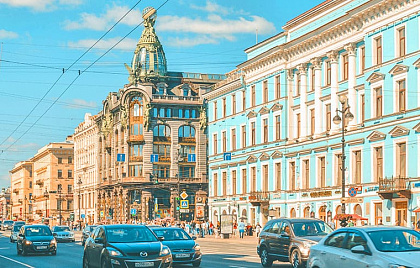Vasilyevsky Island
Vasilyevsky Island is the biggest and the best known of all islands of St.Petersburg. It is separated from the remaining part of the city by two branches of the Neva river – the Bolshaya Neva and the Malaya Neva. On the third side, it bounds the Gulf of Finland. Until very recently, before the Western High Speed Diameter road was built, Vasilyevsky Island was totally cut off from the main land in the night hours during the navigation period: metro was closed, and all bridges were open. Petersburgers who reside on Vasilyevsky Island felt themselves real islanders. Still now, Vasilyevsky Island is a very special part of St.Petersburg. It is said that people who come to live on the Island from other city districts stay there forever, and this applies to their children and grandchildren as well.
Peter I dreamed about having the center of St.Petersburg built on Vasilyevsky Island. Many of Peter I’s plans which looked totally unrealistic were put to life but that dream wasn’t destined to be fulfilled. For several months – during spring ice melting weeks and autumn freeze-up periods – the island was cut off from the mainland. And besides that, a huge part of the island was fully covered with water during floods. But Vasilyevsky Island still has building dating back to Peter I’s time, among them the oldest stone edifice of St.Petersburg – the Menshikov Palace.
The part of the island which is the most interesting part from the architectural and historical pints of view is the so-called Spit of Vasilyevsky Island, a sharp nose formed by the merge of the Bolshaya Neva and the Malaya Neva. The architectural ensemble of the Spit of Vasilyevsky Island – Rostral Colums, the Stock Exchange building (architect Thomas de Thomon), the buildings of warehouses and the Customs House (architect Giovanni Luchini) – was built in the beginning of the 19th century for the needs of the port. However, the port was soon moved further downstream and the magnificent architectural ensemble remained to be the city’s center-piece.
The Kunstkammer – the first museum not only in our city but in Russia – is situated right next to the Spit of Vasilyevsky Island. Further down is the building of the Academy of Sciences, and next to it is the legendary building of Twelve Collegia, which was designed by St.Petersburg’s first architect Domenico Trezzini. Originally it was built to accommodate Peter I’s collegia – or ministries, in today’s language Later, the building housed St.Petersburg State University during many years.
Many research institutes affiliated with the Academy of Sciences are also situated in this part of Vasilyevsky Island. And a little downstream the Neva beyond the Menshikov Palace is the building of the Imperial Academy of Arts (architect Vallin de la Mothe), which is still the most respected arts institution of St.Petersburg.
In front of the Academy of Arts are the famous stairs down to the Neva River adorned with real Egyptian sphinxes. The sphinxes were found during excavation works in Thebes, transported from Egypt to St.Petersburg and installed in front of the Academy of Arts in the 1st half of the 19th century. As time passed, the sphinxes became kind of symbol of St.Petersburg. St.Petersburg is said to be as enigmatic as the famous half-smile of the sphinxes.


















